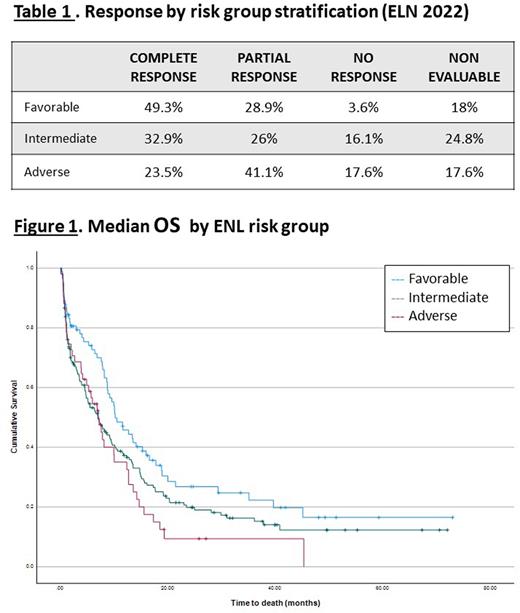Abstract
Introduction: Acute myeloid leukemia (AML) 5-year overall survival (OS) previously reported is 16%, which is half of the median 5y OS in the United States. Therefore, to understand this significant disparity we aim to explore the clinical characteristics of AML patients diagnosed and treated at the National Cancer Institute in Peru.
Methods: We conducted a retrospective analysis of all newly diagnosed AML patients seen at the National Cancer Institute (INEN) in Lima-Peru between 2015 to 2020. We include patients between 18-60 years old who received induction therapy. Exclusion criteria were acute promyelocytic leukemia, and AML secondary to MDS. Demographic and clinical characteristics were obtained from medical records, and risk stratification was done following the new criteria of the European Leukemia Network 2022. Survival analysis was performed using Kaplan Meier in SPSS.
Results: A total of 390 newly diagnosed AML cases met inclusion criteria. The median age at diagnosis was 46 years, and patients were 52.7% male and 47.3% female. According to French American British (FAB) classification, the most common form was M2 (50.9%) followed by M4 (22.8%), M1 (11.9%), M5 (8.7%), and M0 (5.1%). ENL 2022 risk stratification was favorable (22.6%), intermediate (47.1%), adverse (13.9%), and unknown (16.3%). After induction therapy, 32.6% had a complete response (<5% blast in BM), 26.2% partial response, 13.4% no response and 27.8% non-evaluable response. Minimal molecular disease (MRD) was negative in 80.1% (101) of patients who achieved complete response. Response to induction chemotherapy by risk stratification groups is described in Table 1. Median overall survival was 7.2 months [5.8-8.6], and median OS by risk group was 10.1 months for the favorable group, 6.9 and 7 months for the intermediate and adverse respectively (Figure 1). Early death, defined as 60 days from commencing therapy, was 37.3% of all death. During this period, thirty patients went under allogeneic transplant, the median OS was 28.12 months.
Conclusion: AML is a lethal disease in Peru, even for patients who are candidates for intensive chemotherapy, overall survival in this young cohort was dismal compared with reported international outcomes. A third of the deaths are within 60 days of starting the induction, which is related to treatment-related mortality and more studies are needed to narrow this outcome. In this Hispanic cohort, the favorable risk group has better outcomes, as expected, but intermediate and adverse groups have no difference in overall survival or response rates, suggesting intrinsic factors are associated and more cytogenetics and molecular studies are needed in Peruvian population.
Disclosures
No relevant conflicts of interest to declare.
Author notes
Asterisk with author names denotes non-ASH members.


